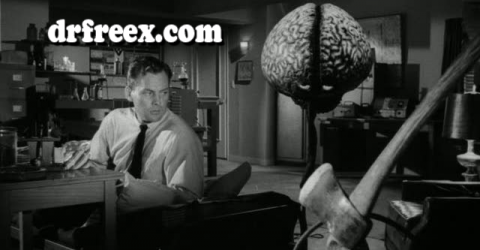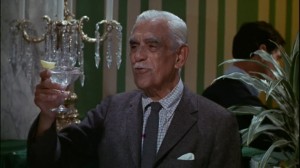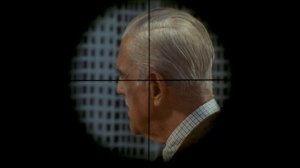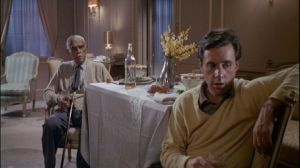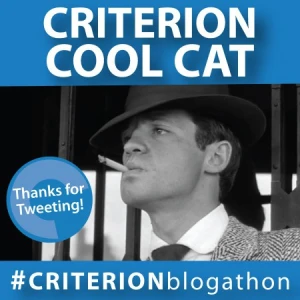If you’ve been with me for any length of time, you know that I like to champion physical media. You may say that’s due to my not being able to afford robust broadband from any of the Great Satans currently controlling Big Cable, but the truth is it’s because we are living in an amazing age for boutique labels.
This week, I’m going to exclaim all over Arrow Films, who’ve been in operation in the UK since 1991, and recently branched out to America. There was a bit of a bobble in the distribution of their superb blu-ray of Mario Bava’s Blood and Black Lace, resulting in the dusting off of my Amazon UK account and importing it myself. That is an extra mile I did not mind walking… except that after watching that gorgeous, candy-coated transfer, I immediately wanted more with a capital M.
 A year later, I have finally gotten my more and it is as remarkable and complete as it is improbable: A box set of four films that quite literally share the same cinematic DNA, marketed under the best-known of its many identities: Blood Bath. Tim Lucas, one of the best genre film historians and critics around today, bears the likely blame for this: in the earliest issues of his essential magazine, Video Watchdog, there was a three-part article tracing the history of these odd, stitched-together movies. Lucas points to these articles as the probable genesis of his magazine, since no other publication would have considered devoting that many pages to such obscurities. Speaking personally, I read those articles and thought, I’m not alone in obsessing over junk food movies.
A year later, I have finally gotten my more and it is as remarkable and complete as it is improbable: A box set of four films that quite literally share the same cinematic DNA, marketed under the best-known of its many identities: Blood Bath. Tim Lucas, one of the best genre film historians and critics around today, bears the likely blame for this: in the earliest issues of his essential magazine, Video Watchdog, there was a three-part article tracing the history of these odd, stitched-together movies. Lucas points to these articles as the probable genesis of his magazine, since no other publication would have considered devoting that many pages to such obscurities. Speaking personally, I read those articles and thought, I’m not alone in obsessing over junk food movies.
I’ll try to keep this brief, as the set covers a lot of ground. Roger Corman, wheeling and dealing internationally after the box office failure of The Intruder (and not incidentally trying to get out from under the thumb of AIP), makes a stop in Yugoslavia and agrees to help fund a crime movie, filmed in English, and provide two stars for the American market. That movie, directed by Rados Novakovic, is Operation Titian. Don’t bother looking for it on the IMDb under that name, you’ll give yourself a headache. It’s there under Operacija Ticijan.
 Operation Titian feels a lot like the krimi movies so popular in Germany at the time, but suffers from not having a script based on a Edgar Wallace novel. The macguffin is a Renaissance painting by Titian, supposedly lost during WWII. A certain Dr. Zaroni (Patrick Magee) arrives, meeting with a shadowy someone who passes him a key to the villa in which the painting is now hidden. Zaroni kills the old man living there and steals the painting, only to discover that it is a copy. That shadowy someone is the old man’s nephew (William Campbell), who has his own plotline about his old fiancee who is marrying a reporter. Said fiancee is also the sister of the policeman who is tracking down Zaroni.
Operation Titian feels a lot like the krimi movies so popular in Germany at the time, but suffers from not having a script based on a Edgar Wallace novel. The macguffin is a Renaissance painting by Titian, supposedly lost during WWII. A certain Dr. Zaroni (Patrick Magee) arrives, meeting with a shadowy someone who passes him a key to the villa in which the painting is now hidden. Zaroni kills the old man living there and steals the painting, only to discover that it is a copy. That shadowy someone is the old man’s nephew (William Campbell), who has his own plotline about his old fiancee who is marrying a reporter. Said fiancee is also the sister of the policeman who is tracking down Zaroni.
There are several more complications and twists, in true krimi fashion. The local actors, performing in English, are quite good; the photography tends toward the pedestrian, but at times produces some exceptional nighttime sequences that benefit not only from the old world architecture of Dubrovnik, but also an obvious reverence for Orson Welles’ Touch of Evil and Carol Reed’s The Third Man. Corman, for his end of the deal, provided two actors who had been working in Ireland with some young turk named Francis Coppola on a horror movie called Dementia 13. Magee does his usual excellent job of playing alternately charming and quietly menacing, often in the same line. Campbell always does best when he is allowed to be a bit hammy, and he does eventually get that chance.
The pertinent point here, though, is that, after having read Lucas’ articles and knowing what eventually became of Operation Titian, I was pretty confident that I would never actually get to see it. And now I have.
Corman had some problems with Novakovic’s finished movie, and had it reworked for the American TV market into Portrait in Terror, the second movie in the box set. Portrait rearranges the sequence of events in Titian, and excises some pretty blatant travelogue footage (think Reptilicus without that time-wasting tour of Denmark). Titian introduced its characters in a lengthy scene at an airport, and it still didn’t do a very good job of it. Portrait almost starts in media res in comparison, and the viewer clicks with the cast much more quickly.
There are some puzzling additions, however. The murder of an extorting dancer, handled obliquely in Titian is now replaced by a bizarre stabbing scene in which only the slightest of efforts was made to match the actors – the costumes are close, but that’s about it (nice work is done finding similar architecture in Venice, California, though). The stabbing is followed by the murderer laboriously carrying the body down long stretches of stairs – in broad daylight – while the camera shows blood dripping on the steps. As the killer is supposedly wearing Magee’s white linen suit – which remains spotless – this becomes egregious rather quickly. He then loads the body into a rowboat and dumps the body in the middle of a crowded bay. It is still daylight.
In Titian, that scene ends with the dancer gasping as the white-suited figure approaches; a few seconds only. In Portrait, it’s closer to five minutes. In Titian, her corpse is discovered during a sports fishing competition; we find she was impaled with a fishing spear. In Portrait, it is much the same, except the scuba diving takes much longer, and as we all know, if a movie is moving slowly, there’s nothing like a scuba diving scene to bring it to a dead stop.
What is unusual is that Portrait runs 15 minutes shorter than Titian, but it’s not an improvement. Operation Titian has a very deliberate pace, it is true, but it has a definite rhythm. That rhythm is chopped up to jarring effect in Portrait in Terror and those strange ill-considered inserts scrub the proceedings of any tension that might have been built up.
Then you get to the next evolution of Operation Titian, and things start to get really weird, as we get into the movie whose name the box set bears: Blood Bath.
Roger Corman, who should have been named Patron Saint of Film Recycling some time ago, tells Jack Hill that it’s his turn to make a movie; he doesn’t so much care what kind of movie, so long as he uses 30 minutes of Operation Titian footage (this is the same MO that resulted in Peter Bogdanovich’s Targets). William Campbell balks, but is eventually brought back on to flesh out his character in Titian: this time his  Antonio Sordi is a painter obsessed with his equally artistic ancestor, who was burned at the stake (along with his disturbing paintings) based on the testimony of his mistress. Sordi is also quite insane, believes he is being haunted by the ghost of that mistress, and keeps killing women at her behest, using their corpses as the models for his successful series of paintings called Dead Red Nudes, and then dipping them in a huge wax vat.
Antonio Sordi is a painter obsessed with his equally artistic ancestor, who was burned at the stake (along with his disturbing paintings) based on the testimony of his mistress. Sordi is also quite insane, believes he is being haunted by the ghost of that mistress, and keeps killing women at her behest, using their corpses as the models for his successful series of paintings called Dead Red Nudes, and then dipping them in a huge wax vat.
Please note that there is no blood bathing in the movie, except on the poster.
Now this is a fairly solid concept for a thriller; consult The Psychotronic Encyclopedia of Film and you’ll find half a dozen movies with a similar plot. Jack Hill does some interesting stuff, not the least of which is a surreal nightmare scene where the ghostly mistress torments Sordi. Hill also archly revives the satiric beatnik art milieu of Corman’s Bucket of Blood, with Sid Haig and Jonathan Haze drunkenly searching for the next “art thing” with skills that would make a third grader sneer.
Corman returns from shooting in Europe (Yugoslavia, again!) and once more has problems with the movie, but while Corman was wrapping his movie and Blood Bath was in limbo, Jack Hill has moved on to Spider Baby. Another Corman protege, Stephanie Rothman, gets the nod to “improve” the movie yet again. She does this by inserting a storyline that Sordi is actually a shape-shifting vampire – shape-shifting probably because Campbell rightly wanted more money to come back yet again, so hell, just turn him into another actor entirely. Rothman also manages to get another actor from Hill’s version, Karl Schanzer, as the guru of the art beatniks, Max. Schanzer is saddled by one of the worst fake moustaches in film history, but he also becomes one of the most improbable heroes in that same history.
Blood Bath is a surreal experience, to say the least; my main source of confusion is exactly where the hell this movie is taking place. I was quite comfortable assuming it was in California, given the Venice locations, and then Campbell starts talking about living in a clock tower active since the 11th century, so I guess we’re still in Dubrovnik? Really, the worst thing that can be said about Blood Bath is that it plays out as exactly what it is: three movies stitched together, and at least one feels like a deliberate intrusion on the others. Still, at a slim b-picture 62 minutes, it has little time to wear out its welcome.
62 minutes? That works for a double feature (it played on a double bill with Curtis Harrington’s Queen of Blood), but won’t do for TV syndication, where most movies are slotted in a two hour block. So, like the villain in a video game, Operation Titian mutates into its final form, Track of the Vampire.
The name of the game here is padding, so yet another actor becomes the black-clad vampire to chase yet another woman through California scenery to the tune of nearly ten minutes. There is, apropos of next-to-nothing, a lengthy dance scene on a beach, but most remarkable of all is the return of that extorting dancer from Titian and Portrait, and Patrick Magee – absent except for a freeze frame in Blood Bath. Campbell and Magee have been re-dubbed in these scenes to manufacture an entirely new subplot about cheating wives and avenging husbands. All this manages to bring Track up to the requisite 82 minutes, but it does the overall movie no favors whatsoever.
Track of the Vampire is, sadly, the version I was most familiar with all these years, from several viewings on local horror movie slots – and the story never got any more comprehensible with repetition, let me tell you. That’s also where Lucas first picked up the thread, as he explains in the real jewel of the collection, a video essay titled “The Trouble with Titian – Revisited”, With all respect to Xan Cassavetes, it could have also been titled “Operation Titian: A Less-Than-Magnificent Obsession”.
If you’ve never watched a movie with a Tim Lucas commentary track, you’re in for a treat, and probably going to develop a bit of an obsession for them yourself. Track down any number of Mario Bava blu-rays (like the aforementioned Blood and Black Lace) with his work on them – Lucas literally wrote the book on Bava movies – and you will be amazed by the amount of information he can pack into less than 90 minutes. “The Trouble with Titian” represents such a magnificent visual expansion of that three-part article, along with new information he has gleaned over the years – it makes you wish every article he has written could be realized in such a form. Side-by-side comparisons of the different versions, freeze frames – a lot of time and care went into this supplement, and it shows.
That disc also holds video interviews with Jack Hill and Sid Haig, and a gallery of around 30 pictures. A pack-in booklet has compact but fairly complete bios on Campbell, Magee and Haig, and there is a poster of the box cover art and the much more lurid theatrical poster for Blood Bath. It’s a nice bonus that labels like Arrow care enough to make reversible covers for the disc box itself, allowing me to indulge my more vulgar urges and swap that cover around for the garish, blood-dripping version.
As I said before, I never thought I would see Operation Titian in this lifetime, much less in the company of its strange, Frankensteinian descendants, and I certainly never thought I’d see them in such immaculate condition in 2K restorations! There is no reason for this box set to exist, and yet it does, and for that we should all be grateful. It traces, in great detail, the events in a very small but vibrant corner of the independent film industry, the creative arc of what were thought to be a series of disposable movies. But are any movies truly disposable?
Tim Lucas and I were not the only people struck by the strangeness of Track of the Vampire; chance cinematic encounters like this are just as likely to engender curiosity and passion as stumbling onto a viewing of an acclaimed art film. Arrow Films once again has my respect for approaching movies that have long been the subject of fuzzy public domain discs, and treating them with the same reverence and respect as their much more hoity-toity, supposedly more “respectable” contemporaries.
